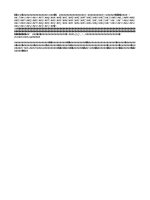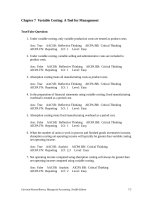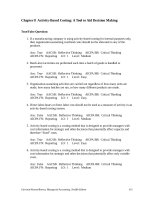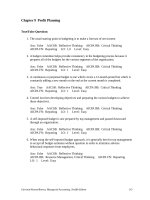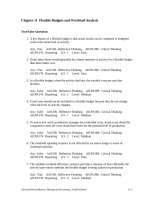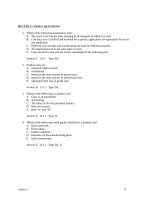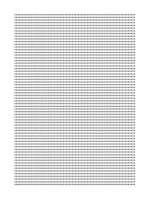Test bank managerial accounting by hilton 9e chapter03
Bạn đang xem bản rút gọn của tài liệu. Xem và tải ngay bản đầy đủ của tài liệu tại đây (146.56 KB, 36 trang )
MULTIPLE CHOICE QUESTIONS
1. Product costing in a manufacturing firm is the process of:
A. accumulating the company's period costs.
B. allocating costs among the firm's departments.
C. placing a value on the company's fixed assets.
D. assigning costs to the firm's inventory.
E. assigning costs to the company's managers.
Answer: D LO: 1 Type: RC
2. Which of the following statements is true?
A. Service firms have little need for determining the cost of their services.
B. The concept of product costing is relevant only for manufacturing firms.
C. The cost of year-end inventory appears on the balance sheet as an expense.
D. Service companies use cost information for planning and control purposes.
E. Mining and petroleum companies have no inventoriable costs.
Answer: D LO: 1 Type: RC
3. Which of the following manufacturers would most likely use job-order costing?
A. Chemical manufacturers.
B. Microchip processors.
C. Custom-furniture manufacturers.
D. Gasoline refiners.
E. Fertilizer manufacturers.
Answer: C LO: 3 Type: RC
4. A custom-home builder would likely utilize:
A. job-order costing.
B. process costing.
C. mass customization.
D. process budgeting.
E. joint costing.
Answer: A LO: 3 Type: RC
5. Which of the following types of companies would most likely use process costing?
A. Aircraft manufacturers.
B. Textile manufacturers.
C. Textbook publishers.
D. Custom-machining firms.
E. Shipbuilders.
Answer: B LO: 3 Type: RC
Hilton, Managerial Accounting, Seventh Edition 48
6. A manufacturing firm produces goods in accordance with customer specifications, commencing
production upon receipt of a purchase order. To accumulate the cost of each order, the company
would use a:
A. job-cost record.
B. cost allocation matrix.
C. production log.
D. overhead sheet.
E. manufacturing cost record.
Answer: A LO: 3 Type: RC
7. A typical job-cost record would provide information about all of the following items related to an
order except:
A. the cost of direct materials used.
B. administrative costs.
C. direct labor costs incurred.
D. applied manufacturing overhead.
E. direct labor hours worked.
Answer: B LO: 3 Type: RC
8. Which of the following statements about material requisitions is false?
A. Material requisitions are often computerized.
B. Material requisitions are a common example of source documents.
C. Material requisitions contain information that is useful to the cost accounting department.
D. Material requisitions authorize the transfer of materials from the production floor to the raw
materials warehouse.
E. Material requisitions are routinely linked to a bill of materials that lists all of the materials
needed to complete a job.
Answer: D LO: 3 Type: RC
9. Pruitt Company has developed an integrated system that coordinates the flow of all goods,
services, and information into and out of the organization, working with raw material vendors as
well as customers to improve service and reduce costs. The firm is said to be using:
A. participative management.
B. top-down management.
C. strategic cost management.
D. supply chain management.
E. management by objectives (MBO).
Answer: D LO: 3 Type: RC
49
Hilton, Managerial Accounting, Seventh Edition
10. The assignment of direct labor cost to individual jobs is based on:
A. an estimate of the total time spent on the job.
B. actual total payroll cost divided equally among all jobs in process.
C. estimated total payroll cost divided equally among all jobs in process.
D. the actual time spent on each job multiplied by the wage rate.
E. the estimated time spent on each job multiplied by the wage rate.
Answer: D LO: 3 Type: N
11. The total production cost of a job is composed of:
A. direct material and direct labor.
B. direct material, direct labor, manufacturing overhead, and outlays for selling costs.
C. direct material, direct labor, manufacturing overhead, and outlays for both selling and
administrative costs.
D. direct material, direct labor, and applied manufacturing overhead.
E. direct material, direct labor, and actual manufacturing overhead.
Answer: D LO: 3 Type: RC
12. Manufacturing overhead:
A. includes direct materials, indirect materials, indirect labor, and factory depreciation.
B. is easily traced to jobs.
C. includes all selling costs.
D. should not be assigned to individual jobs because it bears no obvious relationship to them.
E. is a pool of indirect production costs that must somehow be attached to each unit
manufactured.
Answer: E LO: 3 Type: RC
13. As production takes place, all manufacturing costs are added to the:
A. Work-in-Process Inventory account.
B. Manufacturing-Overhead Inventory account.
C. Cost-of-Goods-Sold account.
D. Finished-Goods Inventory account.
E. Production Labor account.
Answer: A LO: 2, 5 Type: RC
14. Which of the following statements regarding work in process is not correct?
A. Work in process is partially completed inventory.
B. Work in process consists of direct labor, direct material, and manufacturing overhead.
C. Work-in-Process Inventory is debited to record direct material used and direct labor incurred.
D. Work-in-Process Inventory appears on the year-end balance sheet.
E. Work-in-Process Inventory is credited when goods are sold.
Answer: E LO: 2, 5 Type: N
Chapter 3
50
15. Which of the following statements about manufacturing cost flows is false?
A. Direct materials, direct labor, and manufacturing overhead are entered in the Work-in-Process
Inventory account.
B. The Finished-Goods Inventory account will contain entries that reflect the cost of goods sold
during the period.
C. The cost of units sold during the period will typically appear on the income statement.
D. When a company sells goods that cost $54,000 for $60,000, the firm will enter $6,000 in an
account entitled Profit on Sale.
E. Units are normally transferred from Work-in-Process Inventory to Finished-Goods Inventory.
Answer: D LO: 2, 5 Type: N
16. Which of the following statements about materials is false?
A. Acquisitions of materials are normally charged to the Purchases account.
B. The use of direct materials gives rise to a debit to Work-in-Process Inventory.
C. The use of indirect materials gives rise to a debit to Manufacturing Overhead.
D. The use of indirect materials gives rise to a credit to Manufacturing Supplies Inventory.
E. Direct materials are accounted for in a different manner than indirect materials.
Answer: A LO: 5 Type: A
17. Longview Corporation recently used $72,000 of direct materials and $3,000 of indirect materials
in production activities. The journal entries reflecting these transactions would include:
A. a debit to Raw-Material Inventory for $72,000.
B. a debit to Manufacturing Overhead for $3,000.
C. a credit to Manufacturing Overhead for $3,000.
D. a debit to Work-in-Process Inventory for $75,000.
E. a debit to Manufacturing Overhead for $75,000.
Answer: B LO: 5 Type: A
18. A review of a company's Work-in-Process Inventory account found a debit for materials of
$67,000. If all procedures were performed in the correct manner, this means that the firm:
A. also recorded a credit to Raw-Material Inventory.
B. also recorded a credit to Manufacturing Supplies Inventory.
C. was accounting for the usage of direct materials.
D. was accounting for the usage of indirect materials.
E. was accounting for the usage of direct materials by also crediting the Raw-Material Inventory
account.
Answer: E LO: 5 Type: N
51
Hilton, Managerial Accounting, Seventh Edition
19. Oregon Manufacturing incurred $106,000 of direct labor and $11,000 of indirect labor. The
proper journal entry to record these events would include a debit to Work in Process for:
A. $0 because Work in Process should be credited.
B. $0 because Work in Process is not affected.
C. $11,000.
D. $106,000.
E. $117,000.
Answer: D LO: 5 Type: A
20. The following information relates to October:
Production supervisor's salary: $2,500
Factory maintenance wages: 250 hours at $8 per hour
The journal entry to record the preceding information is:
A. Manufacturing Overhead
4,500
Wages Payable
B. Wages Payable
4,500
Manufacturing Overhead
C. Work-in-Process Inventory
4,500
Wages Payable
D. Wages Payable
4,500
Work-in-Process Inventory
E. Work-in-Process Inventory
2,500
Manufacturing Overhead
2,000
Wages Payable
4,500
4,500
4,500
4,500
4,500
Answer: A LO: 5 Type: A
21. Electricity costs that were incurred by a company's production processes should be debited to:
A. Utilities Expense.
B. Accounts Payable.
C. Cash.
D. Manufacturing Overhead.
E. Work-in-Process Inventory.
Answer: D LO: 5 Type: A
22. The journal entry needed to record $5,000 of advertising for Westwood Manufacturing would
include:
A. a debit to Advertising Expense.
B. a credit to Advertising Expense.
C. a debit to Manufacturing Overhead.
D. a credit to Manufacturing Overhead.
E. a debit to Projects-in-Process.
Answer: A LO: 5 Type: A
Chapter 3
52
23. Regency Company incurred $90,000 of depreciation for the year. Eighty percent relates to the
firm's production facilities, and 20% relates to sales and administrative offices. If all items are
handled in the proper manner, a review of the company's accounting records should reveal a:
A. debit to Depreciation Expense for $90,000.
B. debit to Manufacturing Overhead for $90,000.
C. debit to Manufacturing Overhead for $72,000.
D. debit to Work-in-Process Inventory for $18,000.
E. credit to Cash for $90,000.
Answer: C LO: 5 Type: A
24. The process of assigning overhead costs to the jobs that are worked on is commonly called:
A. service department cost allocation.
B. overhead cost distribution.
C. overhead application.
D. transfer costing.
E. overhead cost apportionment.
Answer: C LO: 4, 5 Type: RC
25. Which of the following is the correct method to calculate a predetermined overhead rate?
A. Budgeted total manufacturing cost ÷ budgeted amount of cost driver.
B. Budgeted overhead cost ÷ budgeted amount of cost driver.
C. Budgeted amount of cost driver ÷ budgeted overhead cost.
D. Actual overhead cost ÷ budgeted amount of cost driver.
E. Actual overhead cost ÷ actual amount of cost driver.
Answer: B LO: 4, 5 Type: RC
26. Metro Corporation uses a predetermined overhead rate of $20 per machine hour. In deriving this
figure, the company's accountant used:
A. a denominator of budgeted machine hours for the current accounting period.
B. a denominator of actual machine hours for the current accounting period.
C. a denominator of actual machine hours for the previous accounting period.
D. a numerator of budgeted machine hours for the current accounting period.
E. a numerator of actual machine hours for the current accounting period.
Answer: A LO: 4, 5 Type: N
27. Horton Company applies overhead based on direct labor hours. At the beginning of 20x1, the
company estimated that manufacturing overhead would be $500,000, and direct labor hours
would be 10,000. Actual overhead by the conclusion of 20x1 amounted to $400,000. On the
basis of this information, Horton's 20x1 predetermined overhead rate is:
A. $0.02 per direct labor hour.
B. $0.025 per direct labor hour.
C. $40 per direct labor hour.
D. $50 per direct labor hour.
E. none of the above.
53
Hilton, Managerial Accounting, Seventh Edition
Answer: D LO: 4, 5 Type: A
Chapter 3
54
28. Dale Company, which applies overhead at the rate of 190% of direct labor cost, began work on
job no. 101 during June. The job was completed in July and sold during August, having
accumulated direct material and labor charges of $27,000 and $15,000, respectively. On the basis
of this information, the total overhead applied to job no. 101 amounted to:
A. $0.
B. $28,500.
C. $51,300.
D. $70,500.
E. $79,800.
Answer: B LO: 4, 5 Type: A
29. Huxtable charges manufacturing overhead to products by using a predetermined application rate,
computed on the basis of machine hours. The following data pertain to the current year:
Budgeted manufacturing overhead: $480,000
Actual manufacturing overhead: $440,000
Budgeted machine hours: 20,000
Actual machine hours: 16,000
Overhead applied to production totaled:
A. $352,000.
B. $384,000.
C. $550,000.
D. $600,000.
E. some other amount.
Answer: B LO: 4, 5 Type: A
30. Treetops worked on four jobs during its first year of operation: nos. 401, 402, 403, and 404. Nos.
401 and 402 were completed by year-end, and no. 401 was sold at a profit of 40% of cost. A
review of job no. 403's cost record revealed direct material charges of $20,000 and total
manufacturing costs of $25,000. If Treetops applies overhead at 150% of direct labor cost, the
overhead applied to job no. 403 must have been:
A. $0.
B. $2,000.
C. $3,000.
D. $3,333.
E. $5,000.
Answer: C LO: 4, 5 Type: A
31. The left side of the Manufacturing Overhead account is used to accumulate:
A. actual manufacturing overhead costs incurred throughout the accounting period.
B. overhead applied to Work-in-Process Inventory.
C. underapplied overhead.
D. predetermined overhead.
E. overapplied overhead.
Answer: A LO: 5 Type: RC
55
Hilton, Managerial Accounting, Seventh Edition
32. Throughout the accounting period, the credit side of the Manufacturing Overhead account is used
to accumulate:
A. actual manufacturing overhead costs.
B. overhead applied to Work-in-Process Inventory.
C. overapplied overhead.
D. underapplied overhead.
E. predetermined overhead.
Answer: B LO: 5 Type: RC
33. An accountant recently debited Work-in-Process Inventory and credited Manufacturing
Overhead. The accountant was:
A. applying a predetermined overhead amount to production.
B. recognizing receipt of the factory utilities bill.
C. recording a year-end adjustment for an insignificant amount of underapplied overhead.
D. recognizing actual overhead incurred during the period.
E. recognizing the completion of production.
Answer: A LO: 5 Type: N
34. The final step in recognizing the completion of production requires a company to:
A. debit Finished-Goods Inventory and credit Work-in-Process Inventory.
B. debit Work-in-Process Inventory and credit Finished-Goods Inventory.
C. add direct labor to Work-in-Process Inventory.
D. add direct materials, direct labor, and manufacturing overhead to Work-in-Process Inventory.
E. add direct materials to Finished-Goods Inventory.
Answer: A LO: 2, 5 Type: RC
35. Job no. C12 was completed in November at a cost of $18,500, subdivided as follows: direct
material, $3,500; direct labor, $6,000; and manufacturing overhead, $9,000. The journal entry to
record this information is:
A. Finished-Goods Inventory
18,500
Work-in-Process Inventory
18,500
B. Work-in-Process Inventory
18,500
Finished-Goods Inventory
18,500
C. Work-in-Process Inventory
18,500
Raw-Material Inventory
3,500
Wages Payable
6,000
Manufacturing Overhead
9,000
D. Cost of Goods Sold
18,500
Finished-Goods Inventory
18,500
E. Finished-Goods Inventory
18,500
Cost of Goods Sold
18,500
Answer: A LO: 5 Type: A
Chapter 3
56
36. If a company sells goods that cost $70,000 for $82,000, the firm will:
A. reduce Finished-Goods Inventory by $70,000.
B. reduce Finished-Goods Inventory by $82,000.
C. report sales revenue on the balance sheet of $82,000.
D. reduce Cost of Goods Sold by $70,000.
E. follow more than one of the above procedures.
Answer: A LO: 2, 5 Type: A
37. Selto Manufacturing recently sold goods that cost $35,000 for $45,000 cash. The journal entries
to record this transaction would include:
A. a credit to Work-in-Process Inventory for $35,000.
B. a debit to Sales Revenue for $45,000.
C. a credit to Profit on Sale for $10,000.
D. a debit to Finished-Goods Inventory for $35,000.
E. a credit to Sales Revenue for $45,000.
Answer: E LO: 2, 5 Type: A
38. A computer manufacturer recently shipped several laptops to a customer (cost: $25,000) and
billed the customer $30,000. Which of the following options correctly expresses the accounts
that are debited and credited to record this transaction?
A. Debits: Accounts Receivable, Finished-Goods Inventory; credits: Sales Revenue, Cost of
Goods Sold.
B. Debits: Accounts Receivable, Cost of Goods Sold; credits: Sales Revenue, Finished-Goods
Inventory.
C. Debits: Sales Revenue, Cost of Goods Sold; credits: Accounts Receivable, Finished-Goods
Inventory.
D. Debits: Sales Revenue, Finished-Goods Inventory; credits: Accounts Receivable, Cost of
Goods Sold.
E. Debits: Accounts Receivable; credits: Finished-Goods Inventory, Profit on Sale.
Answer: B LO: 5 Type: A
39. Barney Company applies manufacturing overhead by using a predetermined rate of 200% of
direct labor cost. The data that follow pertain to job no. 764:
Direct material cost
Direct labor cost
$55,000
40,000
If Barney adds a 40% markup on total cost to generate a profit, which of the following choices
depicts a portion of the accounting needed to record the sale of job no. 764?
Account Debited
Amount
A. Cost of Goods Sold
$175,000
B. Cost of Goods Sold
$245,000
C. Finished-Goods Inventory
$175,000
D. Finished-Goods Inventory
$245,000
E. Sales Revenue
$245,000
57
Hilton, Managerial Accounting, Seventh Edition
Answer: A LO: 5 Type: A
Chapter 3
58
40. Armada Company applies manufacturing overhead by using a predetermined rate of 150% of
direct labor cost. The data that follow pertain to job no. 831:
Direct material cost
Direct labor cost
$72,000
38,000
If Armada adds a 30% markup on total cost to generate a profit, which of the following choices
depicts a portion of the accounting needed to record the sale of job no. 831?
Account Debited
Amount
A. Accounts Receivable
$167,000
B. Accounts Receivable
$217,100
C. Finished-Goods Inventory
$167,000
D. Finished-Goods Inventory
$217,100
E. Sales Revenue
$217,100
Answer: B LO: 5 Type: A
41. Media, Inc., an advertising agency, applies overhead to jobs on the basis of direct professional
labor hours. Overhead was estimated to be $150,000, direct professional labor hours were
estimated to be 15,000, and direct professional labor cost was projected to be $225,000. During
the year, Media incurred actual overhead costs of $146,000, actual direct professional labor hours
of 14,500, and actual direct labor cost of $222,000. By year-end, the firm's overhead was:
A. $1,000 underapplied.
B. $1,000 overapplied.
C. $4,000 underapplied.
D. $4,000 overapplied.
E. $5,000 underapplied.
Answer: A LO: 5 Type: A
42. Maher, Inc., applies manufacturing overhead at the rate of $60 per machine hour. Budgeted
machine hours for the current period were anticipated to be 80,000; however, a lengthy strike
resulted in actual machine hours being worked of only 65,000. Budgeted and actual
manufacturing overhead figures for the year were $4,800,000 and $4,180,000, respectively. On
the basis of this information, the company's year-end overhead was:
A. overapplied by $280,000.
B. underapplied by $280,000.
C. overapplied by $620,000.
D. underapplied by $620,000.
E. underapplied by $900,000.
Answer: B LO: 5 Type: A
59
Hilton, Managerial Accounting, Seventh Edition
43. Carlson charges manufacturing overhead to products by using a predetermined application rate,
computed on the basis of labor hours. The following data pertain to the current year:
Budgeted manufacturing overhead: $1,600,000
Actual manufacturing overhead: $1,632,000
Budgeted labor hours: 50,000
Actual labor hours: 48,000
Which of the following choices denotes the correct status of manufacturing overhead at year-end?
A. Overapplied by $32,000.
B. Underapplied by $32,000.
C. Overapplied by $68,000.
D. Overapplied by $96,000.
E. Underapplied by $96,000.
Answer: E LO: 5 Type: A
44. Sanger Corporation debited Cost of Goods Sold and credited Manufacturing Overhead at yearend. On the basis of this information, one can conclude that:
A. budgeted overhead exceeded actual overhead.
B. budgeted overhead exceeded applied overhead.
C. budgeted overhead was less than applied overhead.
D. actual overhead exceeded applied overhead.
E. actual overhead was less than applied overhead.
Answer: D LO: 5 Type: N
45. Howard Manufacturing's overhead at year-end was underapplied by $5,800, a small amount given
the firm's size. The year-end journal entry to record this amount would include:
A. a debit to Cost of Goods Sold.
B. a debit to Manufacturing Overhead.
C. a debit to Work-in-Process Inventory.
D. a credit to Cost of Goods Sold.
E. a credit to Work-in-Process Inventory.
Answer: A LO: 5 Type: A
46. Fog Company, which uses labor hours to apply overhead to manufacturing, may have increased
amounts of underapplied overhead at month-end if:
A. suppliers of direct materials have an across-the-board price increase.
B. an accountant failed to record the period's charges for plant maintenance and security.
C. employees are hit hard with a widespread outbreak of the flu.
D. direct laborers are granted a wage increase.
E. outlays for advertising expenditures are increased.
Answer: C LO: 5 Type: N
Chapter 3
60
47. The estimates used to calculate the predetermined overhead rate will virtually always:
A. prove to be correct.
B. result in a year-end balance of zero in the Manufacturing Overhead account.
C. result in overapplied overhead that is closed to Cost of Goods Sold if it is immaterial in
amount.
D. result in underapplied overhead that is closed to Cost of Goods Sold if it is immaterial in
amount.
E. result in either underapplied or overapplied overhead that is closed to Cost of Goods Sold if it
is immaterial in amount.
Answer: E LO: 5 Type: N
48. Under- or overapplied manufacturing overhead at year-end is most commonly:
A. charged or credited to Work-in-Process Inventory.
B. charged or credited to Cost of Goods Sold.
C. charged or credited to a special loss account.
D. prorated among Work-in-Process Inventory, Finished-Goods Inventory, and Cost of Goods
Sold.
E. ignored because there is no effect on the Cash account.
Answer: B LO: 5 Type: RC
49. When underapplied or overapplied manufacturing overhead is prorated, amounts can be assigned
to which of the following accounts?
A. Raw-Material Inventory, Manufacturing Overhead, and Direct Labor.
B. Cost of Goods Sold, Work-in-Process Inventory, and Finished-Goods Inventory.
C. Work-in-Process Inventory, Raw-Material Inventory, and Cost of Goods Sold.
D. Raw-Material Inventory, Finished-Goods Inventory, and Cost of Goods Sold.
E. Raw-Material Inventory, Work-in-Process Inventory, and Finished-Goods Inventory
Answer: B LO: 5 Type: RC
50. Fletcher, Inc., disposes of under- or overapplied overhead at year-end as an adjustment to cost of
goods sold. Prior to disposal, the firm reported cost of goods sold of $590,000 in a year when
manufacturing overhead was underapplied by $15,000. If sales revenue totaled $1,400,000,
determine (1) Fletcher's adjusted cost of goods sold and (2) gross margin.
Adjusted Cost
of Goods Sold
Gross Margin
A.
$575,000
$810,000
B.
$575,000
$825,000
C.
$590,000
$810,000
D.
$605,000
$795,000
E.
$605,000
$810,000
Answer: D LO: 6 Type: A
61
Hilton, Managerial Accounting, Seventh Edition
51. Which of the following statement(s) is (are) correct regarding overhead application?
I.Actual overhead rates result in more accurate but less timely information.
II.Predetermined overhead rates result in less accurate but more timely information.
III.Predetermined overhead rates tend to smooth product costs over time.
A.
B.
C.
D.
E.
III only.
I and II.
I and III.
II and III.
I, II, and III.
Answer: E LO: 6 Type: RC
52. The term "normal costing" refers to the use of:
A. job-costing systems.
B. computerized accounting systems.
C. targeted overhead rates.
D. predetermined overhead rates.
E. actual overhead rates.
Answer: D LO: 6 Type: RC
53. Which of the following statements about the use of direct labor as a cost driver is false?
A. Direct labor is the most commonly used cost driver when calculating a predetermined
overhead rate.
B. Direct labor is gaining in importance in many manufacturing applications with respect to
being a significant cost driver.
C. Direct labor is an inappropriate cost driver to use if a company is highly automated.
D. If direct labor is a good cost driver, increases in direct labor are matched with increases in
manufacturing overhead.
E. Companies can use either direct labor cost or direct labor hours as a cost driver.
Answer: B LO: 6 Type: RC
54. If the amount of effort and attention to products varies substantially throughout a firm's various
manufacturing operations, the firm might consider the use of:
A. a plant-wide overhead rate.
B. departmental overhead rates.
C. actual overhead rates instead of predetermined overhead rates.
D. direct labor hours to determine the overhead rate.
E. machine hours to determine the overhead rate.
Answer: B LO: 6 Type: N
Chapter 3
62
55. In the two-stage cost allocation process, costs are assigned:
A. from jobs, to service departments, to production departments.
B. from service departments, to jobs, to production departments.
C. from service departments, to production departments, to jobs.
D. from production departments, to jobs, to service departments.
E. from the balance sheet (when goods are produced), to the income statement (when goods are
sold).
Answer: C LO: 7 Type: RC
56. Which of the following entities would not likely be a user of job-costing systems?
A. Custom-furniture manufacturers.
B. Repair shops.
C. Hospitals.
D. Accounting firms.
E. None of the above, as all are likely users.
Answer: E LO: 8 Type: N
57. Which of the following would not likely be used by service providers to accumulate job costs?
A. Projects.
B. Contracts.
C. Clients.
D. Processes.
E. All of the above, as service providers cannot use job-costing systems.
Answer: D LO: 8 Type: RC
58. At the Nassau Advertising Agency, partner and staff compensation cost is a key driver of agency
overhead. In light of this fact, which of the following is the correct expression to determine the
amount of overhead applied to a particular client job?
A. (Budgeted overhead ÷ budgeted compensation) x budgeted compensation cost on the job.
B. (Budgeted overhead ÷ budgeted compensation) x actual compensation cost on the job.
C. (Budgeted compensation ÷ budgeted overhead) x budgeted compensation cost on the job.
D. (Budgeted compensation ÷ budgeted overhead) x actual compensation cost on the job.
E. None of the above, because service providers do not apply overhead to jobs.
Answer: B LO: 8 Type: RC
59. In comparison with firms that use plantwide overhead rates and departmental overhead rates,
companies that have adopted activity-based costing will typically use:
A. more cost pools and more cost drivers.
B. more cost pools and fewer cost drivers.
C. fewer cost pools and more cost drivers.
D. fewer cost pools and fewer cost drivers.
E. only one cost pool and one cost driver.
Answer: A LO: 9 Type: RC
63
Hilton, Managerial Accounting, Seventh Edition
EXERCISES
Manufacturing Cost Flows, Journal Entries
60. The selected data that follow relate to the Berger Furniture Company.
Direct material purchased
Direct material used
Direct labor
Manufacturing overhead incurred
Manufacturing overhead applied
$160,000
79,000
170,000
100,000
90,000
During the year, products costing $310,000 were completed, and products costing $316,000 were
sold for $455,000.
Required:
Prepare journal entries to record the preceding transactions and events.
LO: 2, 5 Type: A
Answer:
Raw-Material Inventory
Accounts Payable
160,000
160,000
Work-in-Process Inventory
Raw-Material Inventory
79,000
Work-in-Process Inventory
Wages Payable
170,000
Manufacturing Overhead
Miscellaneous Accounts
100,000
Work-in-Process Inventory
Manufacturing Overhead
90,000
79,000
170,000
100,000
90,000
Finished-Goods Inventory
Work-in-Process Inventory
310,000
Cost of Goods Sold
Finished-Goods Inventory
316,000
Accounts Receivable
Sales Revenue
455,000
Chapter 3
310,000
316,000
455,000
64
Basic Journal Entries, Job-Order Costing
61. Quartz Products started and finished job no. C19 during June. The job required $15,000 of direct
material and 75 hours of direct labor at $12 per hour. The predetermined overhead rate is $16 per
direct labor hour.
During June, direct materials requisitions for all jobs totaled $149,000; the total direct labor hours
and cost were 6,200 hours at $12 per hour; and the total cost of jobs completed was $337,500.
All of these figures include data that pertain to job no. C19.
Required:
A. Prepare journal entries that summarize June's total activity.
B. Determine the cost of job no. C19.
LO: 5 Type: A
Answer:
A. Work-in-Process Inventory
Raw-Material Inventory
B.
149,000
149,000
Work-in-Process Inventory
Wages Payable
74,400
Work-in-Process Inventory
Manufacturing Overhead
99,200
74,400
99,200
Finished-Goods Inventory
Work-in-Process Inventory
337,500
Direct material
Direct labor (75 x $12)
Manufacturing overhead applied (75 x $16)
Total cost of job no. C19
$15,000
900
1,200
$17,100
337,500
Job Costing: Journal-Entry Emphasis
62. Dexter Corporation, which uses a job costing system, had two jobs in process at the start of 20x1:
job no. 59 ($95,000) and job no. 60 ($39,500). The following information is available:
•The company applies manufacturing overhead on the basis of machine hours. Budgeted
overhead and machine activity for the year were anticipated to be $720,000 and 20,000 hours,
respectively.
•The company worked on three jobs during the first quarter. Direct materials used, direct labor
incurred, and machine hours consumed were:
Job No.
59
60
61
65
Direct Material
$18,000
---37,000
Direct Labor
$45,000
25,000
35,000
Machine Hours
900
600
1,200
Hilton, Managerial Accounting, Seventh Edition
•
•
Manufacturing overhead during the first quarter included charges for depreciation ($20,000),
indirect labor ($50,000), indirect materials used ($4,000), and other factory costs ($108,700).
Dexter completed job no. 59 and job no. 60. Job no. 59 was sold for cash, producing a profit
of $24,600 for the firm.
Required:
A.
Determine the company's predetermined overhead application rate.
B.
Prepare journal entries as of March 31 to record the following. (Note: Use
summary entries where appropriate by combining individual job data.)
1. The issuance of direct material to production, and the direct labor incurred.
2. The manufacturing overhead incurred during the quarter.
3. The application of manufacturing overhead to production.
4. The completion of job no. 59 and no. 60.
5. The sale of job no. 59.
LO: 4, 5 Type: A
Answer:
A. Predetermined overhead rate: $720,000 ÷ 20,000 hours = $36 per machine hour
B.
1.
Work-in-Process Inventory
Raw-Material Inventory
55,000*
Work-in-Process Inventory
Wages Payable
105,000**
55,000
105,00
0
* $18,000 + $37,000 = $55,000
**$45,000 + $25,000 + $35,000 = $105,000
2.
3.
4.
Manufacturing Overhead
Accumulated Depreciation
Wages Payable
Manufacturing Supplies Inventory
Miscellaneous Accounts
Work-in-Process Inventory
Manufacturing Overhead
*(900 + 600 + 1,200) x $36 = $97,200
Finished-Goods Inventory
182,700
20,000
50,000
4,000
108,70
0
97,200*
97,200
276,500
*
Work-in-Process Inventory
276,50
0
*No. 59: $95,000 + $18,000 + $45,000 +
(900 x $36) = $190,400
No. 60: $39,500 + $25,000 + (600 x $36) = $86,100
Chapter 3
66
5.
215,000
*
Cash
215,00
0
Sales Revenue
*$190,400 + $24,600 = $215,000
Cost of Goods Sold
Finished-Goods Inventory
67
190,400
190,40
0
Hilton, Managerial Accounting, Seventh Edition
Fundamentals of Manufacturing Accounting
63. Brickman Corporation, which began operations on January 1 of the current year, reported the
following information:
Estimated manufacturing overhead
Actual manufacturing overhead
Estimated direct labor cost
Actual direct labor cost
Total debits in the Work-in-Process account
Total credits in the Finished-Goods account
$ 600,000
639,000
480,000
500,000
1,880,000
920,000
Brickman applies manufacturing overhead to jobs on the basis of direct labor cost and adds a 60%
markup to the cost of completed production when finished goods are sold. On December 31, job
no. 18 was the only job that remained in production. That job had direct-material and direct-labor
charges of $16,500 and $36,000, respectively.
Required:
A. Determine the company’s predetermined overhead rate.
B. Determine the amount of under- or overapplied overhead. Be sure to label your answer.
C. Compute the amount of direct materials used in production.
D. Calculate the balance the company would report as ending work-in-process inventory.
E. Prepare the journal entry(ies) needed to record Brickman’s sales, which are all made on
account.
LO: 2, 4, 5 Type: A
Answer:
A. Predetermined overhead rate: $600,000 ÷ $480,000 = 125% of direct labor cost
B. Actual manufacturing overhead ($639,000) - applied overhead ($500,000 x 125% =
$625,000) = $14,000 underapplied
C. Total debits to Work-in-Process ($1,880,000) - direct labor ($500,000) - applied overhead
($625,000) = direct materials used ($755,000)
D. The only job in production is job no. 18, which has direct material of $16,500 and direct labor
of $36,000. Applied overhead amounts to $45,000 ($36,000 x 125%), yielding a total job
cost of $97,500 ($16,500 + $36,000 + $45,000).
E. The company’s cost of goods sold equals $920,000, resulting in sales revenues of $1,472,000
($920,000 x 160%). Thus:
Accounts Receivable
1,472,0
00
1,472,0
00
Sales Revenue
Cost of Goods Sold
Chapter 3
920,000
68
Finished-Goods Inventory
69
920,000
Hilton, Managerial Accounting, Seventh Edition
Job-Costing Computations, Overhead Application
64. Montgomery, Inc., which uses a job-costing system, is a labor-intensive firm, with many skilled
craftspeople on the payroll. Job no. 789 was the only job in process on January 1, having costs of
$22,500 as of that date. Direct materials used and direct labor incurred during January were:
Job No.
789
790
791
Direct Materials
$ 2,000
9,000
14,000
Direct Labor
$ 6,000
10,000
8,000
Job no. 791 was the only job in production as of January 31.
Required:
A. Should Montgomery use direct labor or machine hours as a cost driver. Why?
B. Assume that the company decided to use direct labor as its cost driver. If the budgeted
amounts of direct labor and manufacturing overhead are anticipated to be $200,000 and
$300,000, respectively, what is the firm's predetermined overhead rate?
C. Compute the cost of work-in-process inventory as of January 31.
D. Compute the cost of jobs completed during January.
E. Suppose that the company sold all of its completed jobs, adding a 40% markup to cost. How
much would the firm report as sales revenue?
LO: 4, 5 Type: A
Answer:
A. The company should use direct labor because it is a labor-intensive firm, with many
skilled craftspeople on the payroll. More than likely, a majority of overhead is
"driven" by people rather than machine operation.
B.
$300,000 ÷ $200,000 = 150% of direct labor cost
C.
Direct material
Direct labor
Manufacturing overhead ($8,000 x 150%)
Total cost of job no. 791
$14,000
8,000
12,000
$34,000
D.
Beginning work in process
Direct material ($2,000 + $9,000)
Direct labor ($6,000 + $10,000)
Manufacturing overhead ($16,000 x 150%)
Total cost of job nos. 789 and 790
$22,500
11,000
16,000
24,000
$73,500
E.
Sales revenue: $102,900 ($73,500 x 140%)
Chapter 3
70
Overview of Job-Costing Systems, Overhead Accounting
65. Rockville, Inc., which uses a job-costing system, began business on January 1, 20x3 and applies
manufacturing overhead on the basis of direct-labor cost. The following information relates to
20x3:
• Budgeted direct labor and manufacturing overhead were anticipated to be $200,000 and
$250,000, respectively.
• Job nos. 1, 2, and 3 were begun during the year and had the following charges for direct
material and direct labor:
Job No.
1
2
3
•
•
Direct Materials
$145,000
320,000
55,000
Direct Labor
$35,000
65,000
80,000
Job nos. 1 and 2 were completed and sold on account to customers at a profit of 60% of cost.
Job no. 3 remained in production.
Actual manufacturing overhead by year-end totaled $233,000. Rockville adjusts all underand overapplied overhead to cost of goods sold.
Required:
A.
Compute the company's predetermined overhead application rate.
B.
Compute Rockville's ending work-in-process inventory.
C.
Determine Rockville's sales revenue.
D.
Was manufacturing overhead under- or overapplied during 20x3? By how much?
E.
Present the necessary journal entry to handle under- or overapplied manufacturing
overhead at year-end.
F.
Does the presence of under- or overapplied overhead at year-end indicate that Rockville's
accountants made a serious error? Briefly explain.
LO: 4, 5 Type: A, N
Answer:
A. $250,000 ÷ $200,000 = 125% of direct labor cost
B.
C.
71
Job no. 3:
Direct material
Direct labor
Manufacturing overhead ($80,000 x 125%)
Total cost of job no. 3
$ 55,000
80,000
100,000
$235,000
Job nos. 1 and 2:
Direct material ($145,000 + $320,000)
Direct labor ($35,000 + $65,000)
Manufacturing overhead ($100,000 x 125%)
Total cost of job nos. 1 and 2
$465,000
100,000
125,000
$690,000
Hilton, Managerial Accounting, Seventh Edition
Sales revenue: $1,104,000 ($690,000 x 160%)
Chapter 3
72
